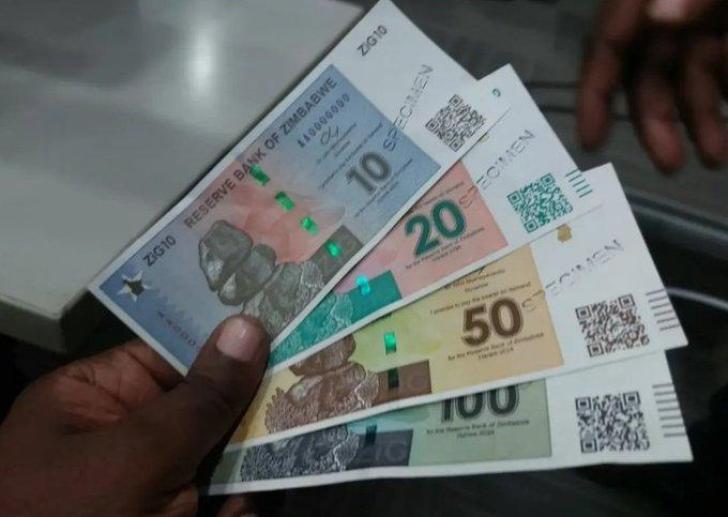News / National
Confidence in Zimbabwe gold currency hits historic low
14 Nov 2024 at 09:52hrs |
0 Views

Confidence in the Zimbabwe Gold (ZiG) currency has dropped to an all-time low, a member of the Reserve Bank of Zimbabwe (RBZ) Monetary Policy Committee has admitted.
Introduced in April this year, the ZiG was initially pegged at ZiG13.50 to one United States dollar. However, the currency has struggled since its launch, experiencing significant volatility. Despite firming slightly in the interbank market, where it traded at ZiG25.48 to the US dollar on November 13, up from ZiG28.68 on November 1, the ZiG is still being rejected by many traders and retailers, with some even demanding payments exclusively in US dollars.
Persistence Gwanyanya, an RBZ Monetary Policy Committee member, acknowledged the deepening lack of trust in the ZiG, attributing it to Zimbabwe's history of hyperinflation and previous failed attempts to maintain a local currency. Speaking at the Insurance Institute of Zimbabwe's annual conference in Victoria Falls, Gwanyanya said, "In our case where confidence has bottomed to historic lows, insisting that the same confidence will drive stability is preposterous."
The ZiG's decline mirrors public reluctance to embrace the currency, given the painful memories of 2008 when Zimbabwe abandoned the Zimdollar amid runaway inflation. Currently, the ZiG is trading at around ZiG43 to one US dollar on the parallel market, further undermining its credibility as a stable store of value.
Despite these challenges, the government remains committed to de-dollarisation, with Finance Minister Mthuli Ncube declaring that the 2025 national budget will focus on boosting confidence in the ZiG.
To restore faith in the currency, Gwanyanya called for a comprehensive strategy, emphasizing the need for the government to price its services exclusively in ZiG. He also suggested that government demand for the ZiG could be a confidence-building measure, particularly through taxes, duties, and user fees.
"There is a need to underwrite the ZiG through super demand," Gwanyanya explained. "Robust use cases and wider adoption of the ZiG are essential. We expect Treasury to increasingly pivot towards the ZiG in the 2025 budget."
As the government works to strengthen the ZiG's standing, it faces the tough task of overcoming years of distrust and economic instability. Many service providers, wary of potential losses, continue to insist on payments in US dollars, highlighting the uphill battle the currency faces in regaining public confidence.
Introduced in April this year, the ZiG was initially pegged at ZiG13.50 to one United States dollar. However, the currency has struggled since its launch, experiencing significant volatility. Despite firming slightly in the interbank market, where it traded at ZiG25.48 to the US dollar on November 13, up from ZiG28.68 on November 1, the ZiG is still being rejected by many traders and retailers, with some even demanding payments exclusively in US dollars.
Persistence Gwanyanya, an RBZ Monetary Policy Committee member, acknowledged the deepening lack of trust in the ZiG, attributing it to Zimbabwe's history of hyperinflation and previous failed attempts to maintain a local currency. Speaking at the Insurance Institute of Zimbabwe's annual conference in Victoria Falls, Gwanyanya said, "In our case where confidence has bottomed to historic lows, insisting that the same confidence will drive stability is preposterous."
The ZiG's decline mirrors public reluctance to embrace the currency, given the painful memories of 2008 when Zimbabwe abandoned the Zimdollar amid runaway inflation. Currently, the ZiG is trading at around ZiG43 to one US dollar on the parallel market, further undermining its credibility as a stable store of value.
Despite these challenges, the government remains committed to de-dollarisation, with Finance Minister Mthuli Ncube declaring that the 2025 national budget will focus on boosting confidence in the ZiG.
To restore faith in the currency, Gwanyanya called for a comprehensive strategy, emphasizing the need for the government to price its services exclusively in ZiG. He also suggested that government demand for the ZiG could be a confidence-building measure, particularly through taxes, duties, and user fees.
"There is a need to underwrite the ZiG through super demand," Gwanyanya explained. "Robust use cases and wider adoption of the ZiG are essential. We expect Treasury to increasingly pivot towards the ZiG in the 2025 budget."
As the government works to strengthen the ZiG's standing, it faces the tough task of overcoming years of distrust and economic instability. Many service providers, wary of potential losses, continue to insist on payments in US dollars, highlighting the uphill battle the currency faces in regaining public confidence.
Source - newsday
Join the discussion
Loading comments…































